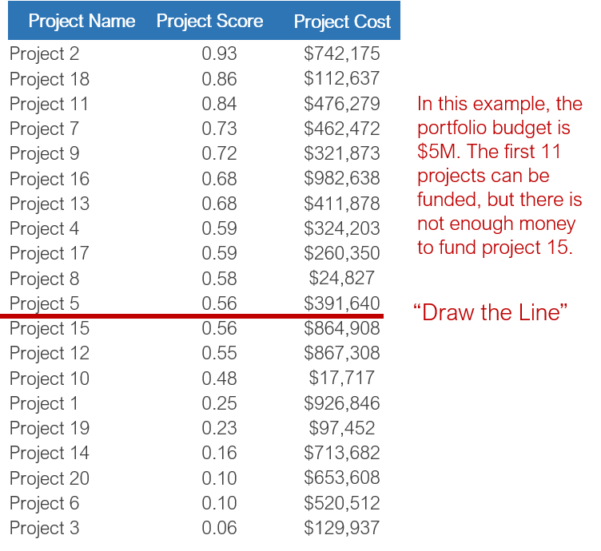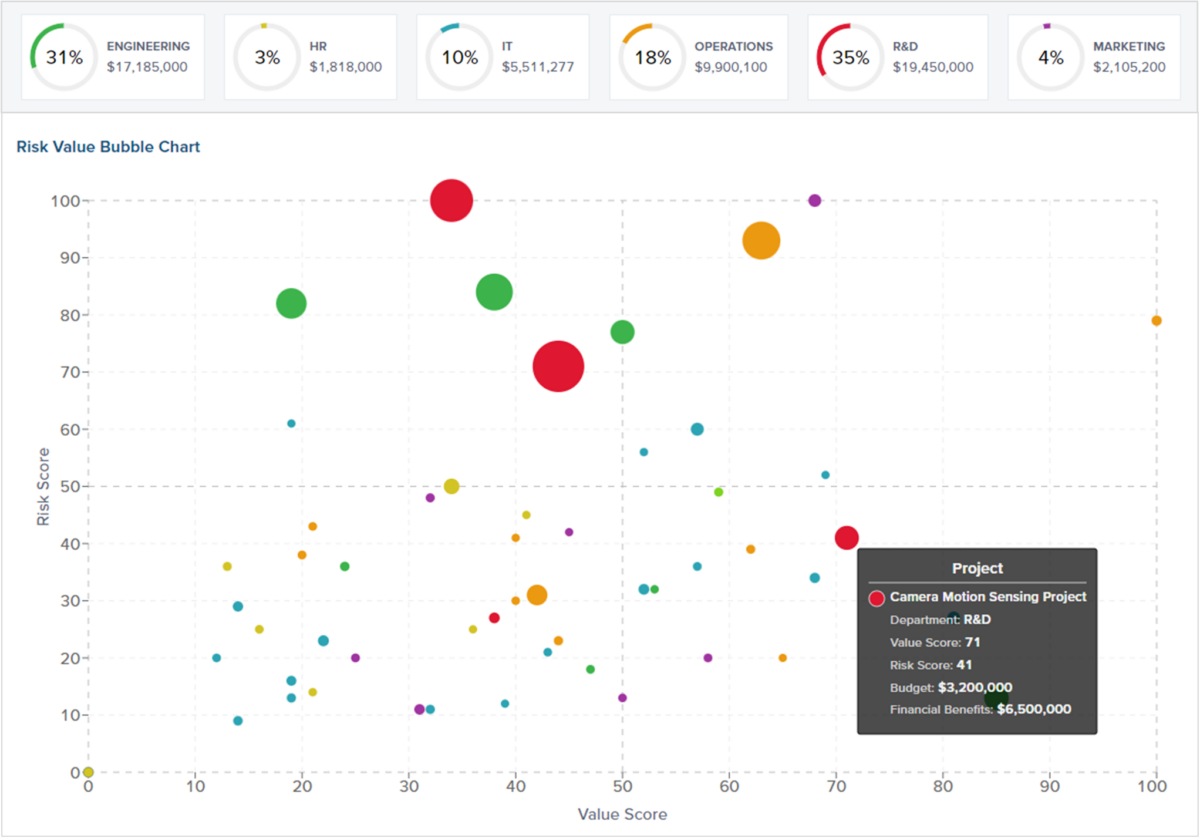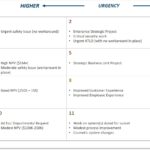Why is Project Prioritization Important?
Project Prioritization is About Maximizing Value
Project prioritization (and by extension, portfolio management) is about delivering the maximum value possible through programs and projects. In order to maximize value delivery, governance teams that approve work need to share a common view of “value” in order to select the most valuable work and assign the right resources to that work. Understanding the relative “value” of each program and project in the portfolio is at the heart of portfolio management and determines what work is selected, how it is prioritized, where resources are allocated, etc. In order to select a winning portfolio, every governance team needs to share a common understanding of value; without it, you’ll fail to realize the full potential of your portfolio. Project prioritization using a portfolio scoring model helps evaluate project value.
However, the definition of “value” will differ at every company because every company has different strategic goals, places varying emphasis on financial metrics, and has different levels of risk tolerance. Furthermore, even within a company, each department may interpret the strategic goals uniquely for their organization. Hence, “value” is not clear cut or simple to define. Any organization that manages a portfolio of projects needs to define and communicate what kind of project work is of highest value.
Assessing Project Value
Assessing project value is particularly important in the first phase of the portfolio lifecycle (Define Portfolio Value) via a work intake process. The only way to have a winning portfolio is to include winning projects, and this requires that project proposals be evaluated. When evaluating new projects for inclusion in the portfolio, a governance team must understand the relative value of the proposed project in relation to the rest of the projects in the portfolio; this will help inform the governance team’s decision to approve, deny, or postpone the project. Every project has inherent value, but that value is relative when compared to other projects. Some projects are transformational in nature and are highly valuable. Other projects may introduce small incremental change and could be of lower value. However, without a consistent approach to measuring the relative value of all projects it is possible for lower value projects to move forward at the expense of higher value projects. This is why a governance team needs a consistent way to measure project value.
“Priorities create a ‘true north’ which establishes a common understanding of what is important. Without a clear and shared picture of what matters most, lower-value projects can move forward at the expense of high-value projects.”
The Right Tool for Assessing Project Value – The Portfolio Scoring Model
There are many ways to prioritize projects, but the best tool for consistent project prioritization is a portfolio scoring model. Sometimes organizations will want to quickly come up with a stack ranking of projects and apply simpler approaches to prioritize work. This can involve long workshops with senior leaders to establish a rank ordered list of projects. While this approach can be useful in certain instances, it is not easily repeatable. In contrast, a scoring model provides a numeric score that can easily be used to compare projects. Moreover, organizations can also compare the project score of current projects against the project scores of completed projects to understand whether the relative value of projects in the portfolio is less than or greater than the value of completed projects.
The portfolio scoring model includes: the criteria in the model, the weight (importance) of each criterion, and scoring anchors to assess each criterion (e.g. none = 0, low =1, medium = 2, high = 4). A poor scoring model will not adequately differentiate projects and can give the governance team a false sense of precision in measuring project value. A good scoring model will align the governance team on the highest value work and measure the risk and value of the portfolio. Good project prioritization scoring models focus on value criteria and risk criteria:
- VALUE CRITERIA evaluates the relative value of a project based on relevant criteria and can include Strategic Criteria (measuring strategic alignment against your organization’s strategic objectives), Financial Criteria (companies should incorporate financial benefit into the scoring model such as net present value, return on investment, payback, earnings before interest and taxes, etc.), and other Business Drivers (other criteria such as customer satisfaction, market growth, quality improvement, or employee satisfaction) to evaluate the value of their projects.
- RISK CRITERIA measures the “riskiness” of the project; this is not about evaluating individual projects risks but evaluating the overall level of risk associated with a project. This is similar to evaluating the risk of an individual stock. Remember, if you could only choose one of two investments that each have the same return, you will always go with the least risky option. Sample risk criteria can include: Complexity risk (an evaluation of the complexity of the project requirements, teams involved, familiarity with developing the solution), Organizational impact (an evaluation of the organizational change required, the impact to the organization, and the ability to absorb the changes), Resource risk (an evaluation of the use of critical resources), Dependency risks (an evaluation of the project dependencies to other high profile projects), Regulatory risk (an evaluation of the organization’s understanding of how to address any regulatory requirements – if applicable).

There are various approaches to building a good portfolio scoring model, and we believe it is worthwhile to invest a little time with decision makers to build a robust model from the beginning. For teams that need to manage a high volume of work requests, check out our post on how to use a priority matrix.
VIDEO: How to Prioritize Projects Using Acuity PPM
Acuity PPM Software
How to Use Project Scores
After developing and implementing the portfolio scoring model each project will have a project score. This score is useful during Work Intake to select projects for the portfolio as well as how to assign resources to projects. For many organizations, the process of selecting projects and prioritizing projects is merged together to develop a rank order list of projects where the governance team “draws the line” where budget or resources run out to define the portfolio (see example below). This approach is an acceptable way to begin to use a portfolio scoring model (note: portfolio optimization would yield an overall better portfolio and will be discussed in a future post). The risk related scores generated from this process will further enable portfolio risk management.

Gaylord Wahl of Point B Consulting says that priorities create a ‘true north’ which establishes a common understanding of what is important. Without a clear and shared picture of what matters most, lower-value projects can move forward at the expense of high-value projects. Even though experienced leaders understand the need to focus on a select group of projects, in practice it becomes very difficult. Good companies violate the principal of focus all the time and frequently try to squeeze in “just one more project.”
**PRO TIP: the governance team should discuss the level of project risk before approving and initiating new work
Project Prioritization Is About Focus
Project prioritization is about focus—where to assign resources and when to start the work. It enables the governance team to navigate critical resource constraints and make the best use of company resources. Higher priority projects need the best resources available to complete the work on time and on quality. Resources that work on multiple projects need to understand where to focus their time. When competing demands require individuals to make choices about where to spend their time, the relative priorities need to be obvious so that high-value work is not slowed down due to resources working on lower-value work. You have to be sure that your most important people are working on the most important projects in order to deliver maximum value within existing capacity constraints.
Furthermore, when resources are not available to staff all of the approved projects, lower priority projects should be started later once enough resources are freed up to begin the work. However, not all projects can be initiated immediately. Understanding relative priorities can help direct the timing and sequencing of projects. In some cases, high priority projects may have other project dependencies or resource constraints that require a start date in the future. In other cases, lower priority projects get pushed out into the future. In both cases, schedule priority helps answer the question “when can we start project work?” This is why project prioritization is about focus—where to assign resources and when to start the work.
New Insights of Project Prioritization – the Risk-Value Bubble Chart
The Risk-Value bubble chart is an excellent output of project prioritization and represents a portfolio view of all projects and is one of the best visualizations of the entire project portfolio (and supports portfolio risk management). The resulting risk and value scores help map each project into one of four quadrants and helps senior leaders quickly visualize the entire portfolio by comparing projects based on risk and value. Leadership can quickly identify high-value and low-risk projects to foster the conversation, “how can we get more high value projects in the portfolio?” Likewise, senior leaders can identify low-value and high-risk projects that are an organizational drain and should be avoided. This understanding of the portfolio would have been invisible in the past until project scores had been compiled and visualized in a risk-value bubble chart.
How to Use a Portfolio Risk-Value Bubble Chart
In the example below, the X-axis represents project value (i.e. the value score) and the Y-axis represents the riskiness of the project (i.e. the risk score). The bubble size can be based on either financial cost or financial benefit (or another measure). Additional color coding can be added to differentiate projects based on strategic goals, departmental alignment, or other categorical information.

Projects will be mapped to one of four quadrants:
- Low value – Low risk: these projects tend to be operational projects (aka “run the business” projects)
- Low value – High risk: these types of projects should generally be avoided unless there is a company mandate or regulatory compliance issue.
- High value – High risk: these types of projects tend to grow the business or even transform the business but have a higher risk profile. Organizations should be selective in how many of these types of projects to take on so as not to exceed the agreed upon risk tolerance.
- High value – Low risk: these are the best types of projects because they deliver high value with far lower risk. Organizations should generally take on as many of these types of projects as allowed by budgetary and resource constraints.

The Portfolio Manager and PMO should monitor the risk-value bubble chart and use it in governance meetings to evaluate how best to balance the portfolio. Organizations may unknowingly be over-investing in certain areas of the business, take on more portfolio risk than necessary, or “leave money on the table” by investing in high risk/low value projects that could be better invested in other projects.
Prioritize Your Projects With Acuity PPM Project Portfolio Management Software
Acuity PPM is an excellent lightweight project portfolio management solution that replaces spreadsheets. Acuity PPM helps you track project performance, report project and portfolio status to senior leaders, manage and prioritize incoming project requests, visualize strategic roadmaps, allocate resources and manage resource capacity. All of this helps enable strategic agility in a changing environment. With the Acuity PPM project prioritization module you can create a custom scoring model to evaluate and score your projects. The resulting output will create a risk-value bubble chart and a rank-ordered list of your projects.
VIDEO: Gain New Portfolio Insights With a Risk-Value Bubble Chart
Summary of Project Prioritization
Senior leaders need to manage priorities effectively.
- Project prioritization starts with assessing project value
- Senior leaders first need to share a common view of value
- The tool for assessing project value is a portfolio scoring model
- Projects scores improve the project selection process
- Project prioritization is about focus – where to assign resources and when to start the work
Acuity PPM has deep expertise in helping Fortune 500 companies effectively prioritize projects, to learn more, contact us today.
Tim is a project and portfolio management consultant with over 15 years of experience working with the Fortune 500. He is an expert in maturity-based PPM and helps PMO Leaders build and improve their PMO to unlock more value for their company. He is one of the original PfMP’s (Portfolio Management Professionals) and a public speaker at business conferences and PMI events.
[activecampaign form=3]
Project Prioritization With Purpose
This presentation will teach you how to build a portfolio scoring model and put it into practice so that you have a successful project prioritization process.
Why should we prioritize projects?

Project prioritization helps evaluate project value. Since project portfolio management is about delivering the maximum business value through programs and projects, senior leadership needs to share a common view of “value” in order to select and prioritize the most valuable work and assign the right resources to that work. Any organization that manages a portfolio of projects needs to define and communicate what kind of project work is of highest value, hence the need for prioritization.
What is a portfolio scoring model?

A portfolio scoring model is the best tool for consistent project prioritization. A good portfolio scoring model will align the governance team on the highest value work and measure the risk and value of the portfolio. Typical scoring models often include three categories of criteria: 1) Strategic Criteria: to measure the strategic alignment of each project 2) Financial Criteria: to measure quantitative financial value for each project (e.g. net present value (NPV), return on investment (ROI), payback, earnings before interest and taxes (EBIT), etc.) 3) Risk Criteria: measure of the “riskiness” of the project; this is not about evaluating individual projects risks but evaluating the overall level of risk associated with a project. This is similar to evaluating the risk of an individual stock. Remember, if you could only choose one of two investments that each have the same return, you will always go with the least risky option.
How can project priority scores be used?

Firstly, project priority scores can be used to compare projects in the portfolio to understand relative value. Next, the scores can help produce a rank ordered list of projects in the portfolio. The value and risk scores can also be used to create valuable portfolio reports such as the risk-value bubble chart. Over time, by maintaining a history of priority scores, your organization will better understand how new projects compare in value not only to active projects, but all projects that have been in the portfolio. Advanced organizations can also utilize project priority scores to support portfolio optimization.
What is the difference between a portfolio scoring model and a priority matrix?

A portfolio scoring model includes multiple criteria for evaluating a project and results in a numeric score that can used for ranking projects and creating risk-value bubble charts. A priority matrix is a simple tool to categorically prioritize work to help triage requests or support a Kanban intake approach.
Never miss an Acuity PPM article
Don't take our word, listen to what others are saying:
"I find value in all of your articles."
"Your articles are interesting and I am sharing them with my team who have limited project knowledge. They are very useful."



